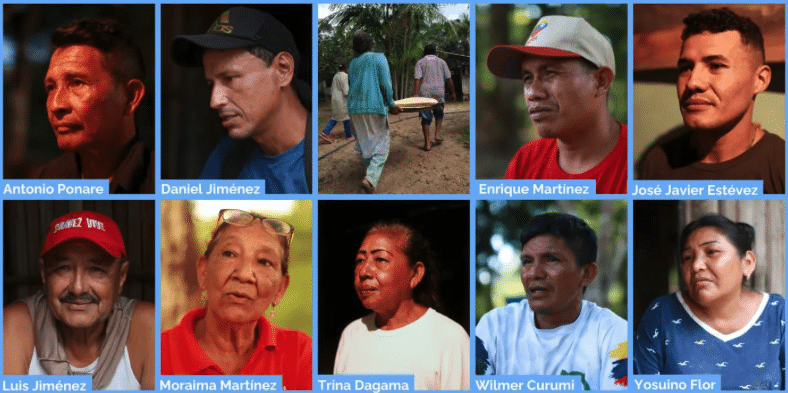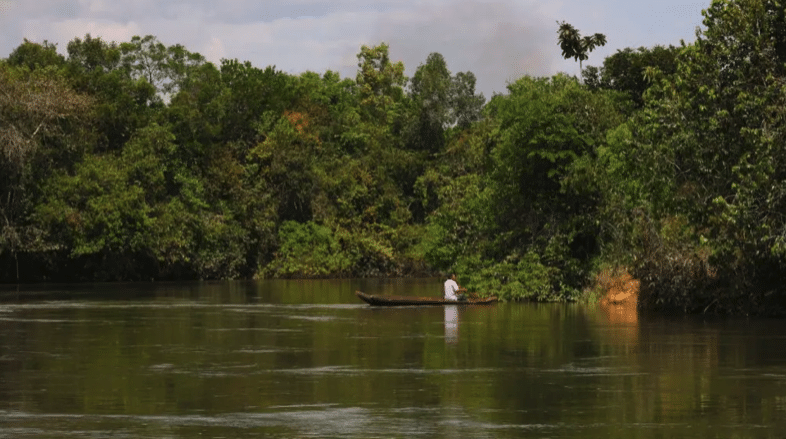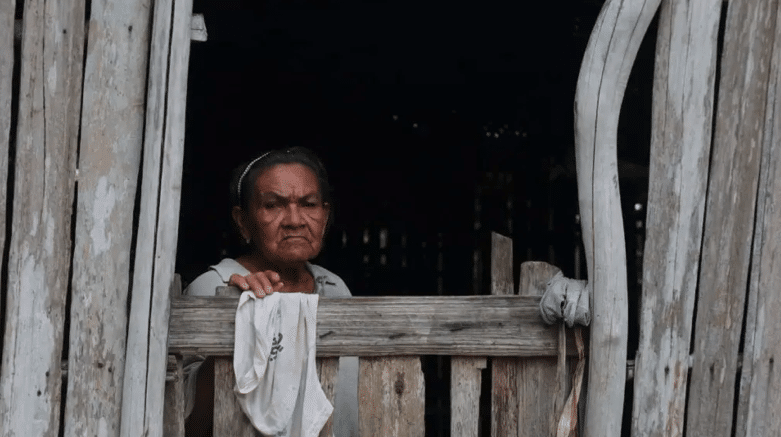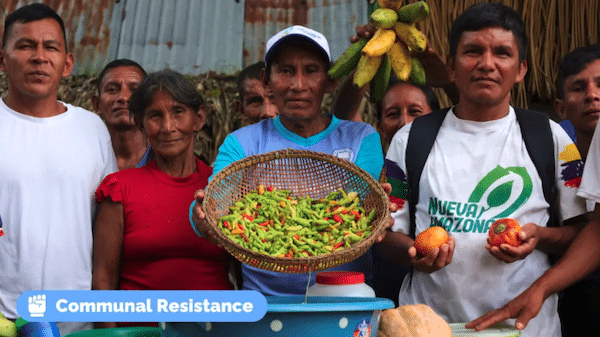Early in the last decade a set of communities along the Cataniapo River started to organize themselves to protect the river’s ecosystem and bolster their agricultural and handicraft production. A few years later, in response to Chávez’s call to build socialist communes, 15 community councils in the area came together to form the Rio Cataniapo Commune.
Today, approximately 1500 people participate in the Río Cataniapo Comune. They come from various ethnic backgrounds, but the majority identify as Indigenous and some still practice common ownership of land. The backbone of the commune’s food economy is yuca, which is used for casabe [flatbread], mañoco [flour], and catara (spicy sauce). The yuca is grown with traditional methods in small “conuco” plots alongside sugarcane, auyama [pumpkin], topocho[small plantain], corn, and cacao. A growing handicraft economy focuses on producing mamure[vine] baskets and furniture.
The commune includes Indigenous communities with people from the Huo̧ttö̧ja̧, Kurripako, Baré, Jivi, and Yeral nations, alongside smaller non-indigenous or “criollo” communities. In this three-part series, members of Rio Cataniapo will discuss the commune’s roots in traditional Indigenous organization, their local economy, and the impact of U.S. sanctions on daily life.
[Note: In various interviews, participants spoke in their Indigenous language, relying on community translators to render their statements in Spanish.]

Antonio Ponare is a campesino and sculptor and is part of the “Unión” Communal Council | Daniel Jiménez is one of the founders of the Río Cataniapo Commune | Enrique Martínez is head of an UBCH and part of the Las Pavas Communal Council | José Javier Estévez is Capitán of El Limonal, a communal council that is part of the Río Cataniapo Commune | Luis Jiménez is part of the Cucurital 2 Communal Council | Moraima Martínez is a spokesperson for the La Unión Communal Council | Trina Dagama is education spokesperson for the La Unión Communal Council | Wilmer Curumi is Productive Economy Spokesperson and part of the Las Pavas Communal Council | Yosuino Flor is part of the Cucurital 1 community in the Rio Cataniapo Comune. (Rome Arrieche)
THE PRESENT AND THE PAST
Enrique Martínez: The idea of the commune is not foreign to the Indigenous peoples of Amazonas. I am Huo̧ttö̧ja̧, and for my people, sharing what we have and living in a community is synonymous with life. We have our self-government, our justice system, and our legitimate authorities based on our traditions: the Council of Elders, the Cacique [generally hereditary], the Capitán [most often elected], and the Shaman.
Before Western culture penetrated our communities, thus generating processes of cultural erosion, the Huo̧ttö̧ja̧ people lived collectively in large churuatas [communal homes covered by palm leaves]. The churuata was the place where they hung their Huärįsą [hammocks]. It was also the space where many rituals and ceremonies took place and the seat of the Council of Elders.
The sabarí [non-Indigenous people] like to divide the land, but our land was, and continues to be here in Las Pavas, collectively owned. It is recognized as collective property by the Venezuelan state.
We are Christians, but preserving our culture and language is important because words tell stories. It is also important that we maintain our legitimate authorities; they can be traced many generations back, and they are the ones that shed light on what to do and how to organize work.
This does not mean, however, that we don’t want the things modernity has brought, from electricity to zinc roofs: we want a better life. In short, while we aren’t the dream community of some anthropologists—who want to find people living in a bubble—we respect our elders, our “living books,” who tell us the stories of our ancestors.
Wilmer Curumí: We are Huo̧ttö̧ja̧, and we have always organized in local governments or self-governments: we are the ones who decide what we will do and how we will solve our problems. We are not keen on outsiders telling us how to organize.
That is why we don’t see communal forms of organization as something that comes from the outside. It’s not a sabarí idea; it is the basis for the organization of many Indigenous peoples.
However, since we are also a commune registered by the Venezuelan state, we have expectations: we self-organize and we decide, but we also give and should receive.
Enrique Martínez: We began to call ourselves a commune when Chávez started to talk about communes… or perhaps it was a bit later, around 2012, because news reaches the Amazonas region late.
I think one of the virtues of the communes, as Chávez thought of them, is that they bring together the social and the productive spheres. The commune does not separate one from the other, which is good because people should not split life from production. The sabarí viewpoint separates the two. We want to bring them back together.
Self-government, which lies at the heart of the Huo̧ttö̧ja̧ way of life, cannot be separated from the conuco that feeds our community or the river that nourishes the conuco. In other words, the commune is popular power plus self-sustenance. But to fully achieve this goal, we need support.

Cataniapo River (Rome Arrieche)
NATURE AND COMMUNITY
Luis Jiménez: Our commune has two defining features. First, geographically, it follows the course of the Cataniapo River, which we protect because it supplies water to the conucos and brings us fish. We also swim in it on hot afternoons, and we clean our clothes and wash the dishes on its banks. Additionally, the river supplies water to our brothers and sisters in Puerto Ayacucho [Amazonas state capital], so we also care for it with their lives in our hearts.
Second, our commune is a multiethnic community where criollos like myself live alongside Huo̧ttö̧ja̧, Kurripako, and Jivi peoples, although there are communities that are exclusively inhabited by one Indigenous group.
Ours is an agriculture-based commune. The agriculture in our communities is conuco-based: we don’t use agrochemicals and we reforest along the river margins to ensure sustainability. The Cataniapo is a natural preserve by decree, but more importantly, it is the river that brings life to our communities and that’s why we have to care for it.
Antonio Ponare: In the Indigenous way of life, there are two pillars: caring for nature, because she is the one that gives us life and sustenance, and sharing what we have, which is the same as caring for the community.
Being united and coming together is so important for us that we call our communal council here “La Unión” [The Union].
The ancestors did not divide the land into parcels, and in fact, the land in Las Pavas [one of the commune’s 15 communal councils] is still collective. Here in La Unión, the land is privately held, but we share much of what we have with our neighbors: at harvest time, we make a sancocho[communal stew] to share the earth’s bounty and help each other with fieldwork when needed.
The conucos in the commune are diversified, but the core product is yuca and its derivatives: casabe, mañoco, and catara.
Wilmer Curumí: The sabarí built a wall between the community and nature, but we don’t want that wall to be there. We must protect the rivers and the trees because they give us the water we drink and the shelter we need. I think that little by little the sabarí are beginning to understand this: the Amazon is the “world’s lung,” and our rivers feed one of the most important hydrographic watersheds on the planet. Devastation of nature cannot go on. Future generations cannot be condemned to live in scorched earth.
Sometimes we wonder if the sabarí realized it too late. We have been caring for the Cataniapo River since we made our home on its banks: it gives us fish and quenches our thirst. Caring for a river is not the task of one person; it’s the task of the community.
The Indigenous communities are the true conservationist guardians who protect Cataniapo. Neither overfishing, nor deforestation, nor agrochemicals are allowed on the river’s margins.
Moraima Martínez: The Indigenous cosmovision—their way of being in the world, organizing, and decision-making—was important in the making of the Cataniapo River Commune. The Indigenous relationship with nature is different and more respectful, and they have a much more collective conception of life. This, of course, feeds into our organization in a positive way: we have weekly assemblies, which is—I think—a far more regular practice than in criollo communes. After the assemblies, those who attend return to their communities to inform of the decisions.
Communication is very efficient at the Cataniapo River Commune. This has a lot to do with the tradition of ringing a bell, which is still used in many Indigenous communities.
Yosuino Flor: I am Kurripako, and I live in a small Kurripako community. In our community, when important news arrives or when there is a meeting, we bang on the bell, and we all come together to hear the news.
We also have the tradition of vaira dapasiaca depina [“sharing,” in Kurripako], which is when we gather to share a meal and talk. Unfortunately, due to economic constraints, this tradition is weaker now. However, during celebrations, we still sit together around a table—everyone brings what they can and we share.
José Javier Estévez: I’m the only non-Indigenous capitán in an Indigenous community here. I’m from Calabozo, Guárico state, but I came here to visit my uncle years ago. It was here that I met my partner and began to live in El Limonal, one of the communal councils in the Río Cataniapo Comune.
Things weren’t easy back then in El Limonal. The criollos were slowly encroaching on the territory, cutting down the forest, and our community wanted to put an end to it. Since I speak Spanish, I was able to establish a dialogue among the parties, and we were able to solve the crisis.
Years later, the community’s capitán got sick and called an assembly. When I arrived, he had already spoken to the community and said: “Javier, I’m old and can no longer be captain. You have done good work for our community, and we respect you. We want you to be the community’s capitán.” Since then, I’ve been the capitán of El Limonal.
In El Limonal, we all meet to solve problems and plan, but I am the one who attends the communal assemblies, often walking for an hour or more each way. When I return, I ring the bell, we drink yucuta [cassava-based drink], and I report back to the community. The cacique also intervenes in these meetings; he gives important advice.
The people in my community are Yeral, Kurripako, and Huo̧ttö̧ja̧. Arguably, I’m the link with other communal councils and the criollo community, but I don’t govern El Limonal: the community governs itself.

Cucurital 1 is a Currupaco communal council. (Rome Arrieche)
CHÁVEZ AND THE COMMUNE
Daniel Jiménez: In his first “Aló Presidente Teórico,” Chávez talked about Simón Rodríguez’s concept of “toparquía,” the government in the territory. This idea was a real inspiration for Comandante Chávez.
He also emphasized that the committees in a communal council and a commune—the housing committee, the water committee, the health committee, etc.—are the institutions of the pueblo and can best address the needs of the people.
Today, It could seem impossible that ministries would ever disappear, but the confederation of communes—or the communal state, as some call it—must dismantle all the existing structures of power and domination inherited from the 4th Republic [1958-99]. Institutions like the parliament or ministries will become obsolete and will be replaced by a confederation of communes. This will require creativity, hard work, and guáramo [a Venezuelan term for boldness or courage], but we have all the requisites to achieve this.
Trina Dagama: Creativity is very important for a commune. President Maduro—to whom Hugo Chávez passed the baton and who has been ratified three times by the Venezuelan pueblo—always says: “the struggle continues.” He’s right. God gave many, diverse abilities to us, and we’ve put them to use in the conuco and within our communal councils.
Daniel Jiménez: Chávez’s most integral legacy is the commune. We’ve come to realize that the Kurripako and Huo̧ttö̧ja̧ peoples—and likely most Indigenous groups in Amazonas—have been living communally for many generations.
In his “Strike at the Helm” speech, Chávez stated that we need to work toward self-government in the territories. The practice of gathering in a community to address problems collectively should not be done in an atomistic way. It should expand and the communes should evolve into a confederation where constituent power becomes real power.
Chávez told us to advance quickly. He even scolded his ministers for their apparent lack of interest in the communes. In Rio Cataniapo, we’ve been working hard for more than ten years to build our commune. However, it hasn’t been easy. The U.S.-led blockade has made all organizational processes more challenging, and in the hardest of times, we had to focus on ensuring our families’ sustenance. Moreover, state institutions haven’t always been supportive, but we celebrate the fact that a transformation is underway—the communes are returning to center stage in Venezuelan politics.
Nevertheless, there’s still a long way to go, because the social property dimension of most communes is usually either very weak or non-existent. A true communal economy doesn’t materialize with the stroke of a magic wand. Rio Cataniapo is a well-organized commune, a bastion of Chavismo. On July 28, President Maduro won the election by a landslide here. Yet we lack communal means of production. This limits our potential as a commune.

